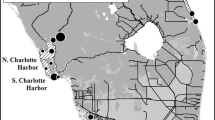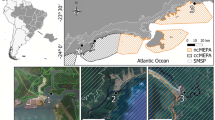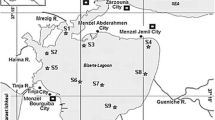Abstract
A considerable amount of chemical data is available for surficial sediments in Port Jackson. Some of the highest concentrations of heavy metals, organochlorines and polycyclic aromatic hydrocarbons of any capital port occur in sediments mantling shallow tributaries and embayments close to central Sydney. However, these data have limited ability to predict adverse effects on living resources and in the absence of toxicological data, sediment quality guidelines (SQG) have been used to assess the possible adverse biological effects of sedimentary contaminants in this estuary. Several SQGs are currently available for both fresh and marine environments, but the scheme used in the current study is based on empirical analysis of matching chemical and biological data compiled by the National Oceanographic and Atmospheric Administration (NOAA) in the U.S. The NOAA SQG can be used to assess individual chemicals, or to estimate the probability of acute sediment toxicity by calculating `mean quotients' for a large range of contaminants. Although many individual chemicals in sediment exceed SQG over extensive parts of Port Jackson, `mean quotient' results suggest that only a small proportion (∼1%) of the harbour may be highly toxic (74% probability of toxicity). However, sediment in a considerably larger proportion of the port (almost 25%) is estimated to have a 49% probability of being toxic using the `mean quotient' approach. These results are indicative at best and contemporaneous chemical/biological/ecotoxicological studies are needed to verify the applicability of SQG developed in the U.S. for use outside North America and site specific studies of this type are still required to determine the toxicity of sediments in Port Jackson.
Similar content being viewed by others
References
Ahmad, N. & R. S. Marolt, 1986. One-step extraction and cleanup procedure for determination of p,p – DDE in fish. J. Ass. Anal. Ch. 68: 581–586.
Ankley, G. T.,D. M. DiToro, D. J. Hansen & W. J. Berry, 1996. Technical basis and proposal for deriving sediment quality criteria for metals. Envir. Toxicol. Chem. 15: 2056–2066.
ANZECC/ARMCANZ, 2000. Australian and New Zealand Guidelines for Fresh and Marine Water Quality. Australian and New Zealand Environment and Conservation Council/ Agricultural and resource Management Council of Australia and New Zealand, Canberra.
Batley, G. E., 1997. ANZECC interim sediment quality guidelines. Commonwealth Scientific and Industrial Research Organisation (CSIRO), Centre for Advanced Analytical Chemistry, Investigation Report, CET/IR57: 55 pp.
Birch, G. F. & S. Taylor, 1995. Towards a regional contaminant framework for central NSW estuaries. Australian Marine Sciences Association Conference, University of Technology, Sydney, NSW.
Birch, G. F., 1996. Sediment-bound metallic contaminants in Sydney's estuaries and adjacent offshore, Australia. Estuar. coast. shelf Sci. 42: 31–44.
Birch, G. F., D. Everden & M. Teutsch, 1996. Dominance of point source in heavy metal distributions in sediments of a major Sydney estuary (Australia). Envir. Geol. 28/1: 1–6.
Birch, G. F., T. Ingleton & S. E. Taylor, 1997. Environmental status of the world's largest coal exporting harbour, Port Hunter, Newcastle, Australia. J. mar. Envir. Eng. 4: 133–145.
Birch, G. F., N. Shotter & P. Steetsel, 1998. The environmental status of Hawkesbury River sediments. Aust. Geogr. Stud. 36/1: 37–57.
Birch, G. F. & S. E. Taylor, 1999. Source of heavy metals in sediments of Port Jackson estuary, Australia. Sci. Tot. Envir. 227: 123–138.
Birch, G. F., 2000. Marine pollution in Australia, with special emphasis on central New South Wales estuaries and adjacent continental margin. Int. J. Envir. Pollut. 13: 1–6, 411–423.
Birch, G. F. & S. E. Taylor, 2000. The distribution and possible sources of organochlorine residues in sediments of a large urban estuary, Port Jackson, Sydney. Aust. J. Earth Sci. 47: 749–756.
Birch, G. F., S. E. Taylor & C. Matthai, 2001. Small-scale spatial and temporal variance in the concentration of heavy metals in aquatic sediments: a review and some new concepts. Envir. Pollut. 113/3, 357–372.
Chapman, P. M., E. A. Power & G. A. Burton, 1992. Integrated assessments in aquatic ecosystems. In Burton, G. A. (ed.), Sediment Toxicity Assessment. Lewis Publishers, Boca Raton, 313–340.
Hyland, J. L., R. F. Van Dolah & T. R. Snoots, 1999. Predicting stress in benthic communities of southeastern U.S. estuaries in relation to chemical contamination of sediments. Envir. Toxicol. Chem. 18/11: 2557–2564.
Ingersoll, C. G., G. R. Biddinger & T. Dillion, 1997. Ecological risk assessment of contaminated sediments. SETAC Special Publication, Pensacola, Florida.
Long, E. R. & L. G. Morgan, 1990. The potential for biological effects of sediment-sorbed contaminants tested in the National Status and Trends Program. NOAA Tech Memo. NOS OMA 52 US National Oceanic and Atmospheric Administration. Seattle, Washington: 175 pp.
Long, E. R., D. D. Macdonald, L. Smith, & F. D. Calder, 1995. Incidence of Adverse Biological Effects Within Ranges of Chemical Concentrations in Marine and Estuarine Sediments. Envir. Manage. 19: 81–97.
Long, E. R. & D. D. MacDonald, 1998. Recommended uses of empirically derived sediment quality guidelines for marine and estuarine ecosystems. Human Ecol. Risk Ass. 4/5: 1019–1039.
Long, E. R., L. J. Field, & D. D. MacDonald. 1998a. Predicting toxicity in marine sediments with numerical sediment quality guidelines. Envir. Toxicol. Chem. 17/4: 714–727.
Long, E. R., D. MacDonald, J. C. Cubbage & C. G. Ingersoll, 1998b. Predicting the toxicity of sediment-associated trace metals with simultaneously extracted trace metal/acid-volatile sulfide concentrations and dry eight-normalised concentrations: a critical comparison. Envir. Toxicol. Chem. 17/5.
Long, E. R., D. MacDonald, C. G. Severn & C. B. Hong, 2000. Classifying the probabilities of acute toxicity in marine sediments with empirically-derived sediment quality guidelines. Envir. Toxic. Chem. 19, No. 10, 2598–2601.
MacDonald, D. D., S. L. Smith, M. P. Wong & P. Mudroch, 1992. The development of Canadian Marine Environmental Quality Guidelines. Ecosystem Science and Evaluation Directorate, Conservation and Protection, Environment Canada, Ottawa, Ontario: 32 pp.
MacDonald, D. D., 1993. Development of an approach to the assessment of sediment quality in Florida coastal waters. Prepared by MacDonald Environmental Sciences, Ltd., Ladysmith, British Columbia. Prepared for Florida department of Environmental Regulation, Tallahasse, Florida. Vols. 1 and 2.
MacDonald, D. D., R. S. Carr, F D. Calder & E. R. Long, 1996. Development and evaluation of sediment quality guidelines for Florida coastal waters. Ecotoxicology 5: 253–278.
McCready, S., D. Slee, G. F. Birch & S. E. Taylor, 2000. the distribution of polycyclic aromatic hydrocarbons in surficial sediments of Sydney Harbour, Australia. Marine Pollution Bulletin, in press.
Author information
Authors and Affiliations
Rights and permissions
About this article
Cite this article
Birch, G.F., Taylor, S.E. Assessment of possible sediment toxicity of contaminated sediments in Port Jackson, Sydney, Australia. Hydrobiologia 472, 19–27 (2002). https://doi.org/10.1023/A:1016300629297
Issue Date:
DOI: https://doi.org/10.1023/A:1016300629297




